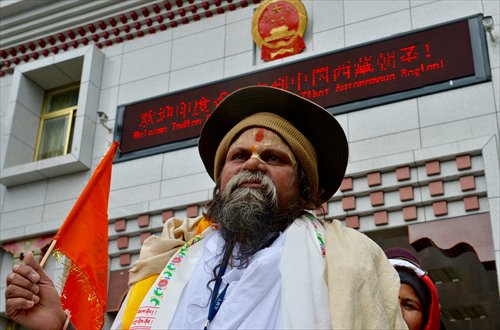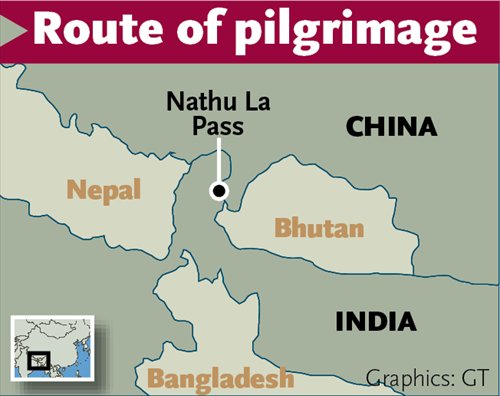New route for Indian pilgrims hailed as sign of warming ties
Opening pass close to disputed area to ease India’s security concerns

An Indian pilgrim goes through the Nathu La Pass at the Chinese border on Monday. A group of more than 40 Indian pilgrims will visit a sacred mountain and lake in China's Tibet. Photo: Xinhua

Graphics: GT
China on Monday reopened a route in the sensitive Sino-Indian border area for pilgrims from India traveling to Tibet, a move analysts believe proves the commitment the two countries have toward upgrading mutual political trust and improving cultural exchanges.
On Monday morning as the Himalayan Nathu La Pass was reopened for pilgrims, the first group of 43 Indian nationals entered southwestern China's Tibet Autonomous Region through the pass to start their 12-day pilgrimage to the sacred religious sites of Mount Kangrinboqe (Mount Kailash) and Lake Mapam Yumco (Lake Manasarovar) in Tibet's Ngari prefecture.
This was the first time the pass was opened after being closed following Sino-Indian border conflicts in 1962.
It was reopened in 2006, but limited to daily trade trips after then Indian prime minister Atal Bihari Vajpayee visited China in 2003 and reached an agreement, according to the Xinhua News Agency.
China's Ambassador to India Le Yucheng said at the opening ceremony at the pass on Monday that the reopened pilgrim route is the result of the important consensus reached by both Chinese and Indian leaders when Chinese President Xi Jinping visited India in September.
The Nathu La Pass sits 4,545 meters above sea level and is wedged between Tibet's Yadong county in Xigaze prefecture, and India's Sikkim State. It is the shortest and highest land pass for trade between China and India.
Around 250 pilgrims, in five groups of 50, will travel to Tibet along the new route this year. Some pilgrims in the first group had dropped out for health reasons.
Another 18 groups of 60 pilgrims will undertake the pilgrimage on the old route along the Qang La Pass, Xinhua quoted local media as saying.
"This [opening] is an extension of Sino-Indian cooperation following the opening for trade in 2006," Jiang Jingkui, director of the Center of South Asian Studies at Peking University, told the Global Times.
"The sacred mountain believed to host Shiva forms an important part of the Hindu religion, therefore the opening serves an important opportunity for the two countries to further strengthen cultural and people-to-people exchanges," Jiang said.
India's Ambassador to China Ashok K Kantha told the Global Times on Monday that the new route will provide greater convenience, in particular for older pilgrims. The oldest among the first batch of pilgrims, who is now 70, would not have joined the journey had it not been for the opening of the new route, Kantha said.
Mount Kangrinboqe and Lake Mapam Yumco in the far west of Tibet are believed to be the seat of Hindu god Shiva. In the past decade, almost 80,000 Indian pilgrims have made the pilgrimage to the region, traveling through the inhospitable and rugged terrain of the Qang La Pass, which sits 5,200 meters above sea level on the China-India-Nepal border.
The new route will shorten the journey from more than 20 days to about eight.
"As Nathu La Pass is near the area where China and India have border disputes, opening the route shows the two countries' rising political mutual trust as well as their confidence and resolve in maintaining peace and stability along the disputed border," Jiang said.
"The region of Nathu La has a strategic significance as India has stationed military facilities in the area. The opening of the route shows the Chinese authorities' sincerity in furthering the two countries' relations. It will also be beneficial to easing security concerns the Indian public have toward China," Ma Jiali, a senior researcher on China-India relations at the China Institute of Contemporary International Relations, told the Global Times.
Jiang, the Peking University expert, believes the new route represents a stronger symbolic impact than benefits of economic trade. Jiang said the climate at Nathu La Pass only allows the region to open for trade from June to September in a year. The limited range of traded goods also restricts the trade prospects, he noted.
Under the current rules, India is allowed to sell 29 types of items such as textiles and herbs in the area, while China can sell 15 products, such as horses and sheep.
Wang Qu contributed to this report